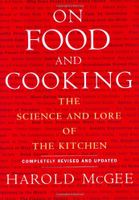Advertisement
Boiling
By Harold McGee
Published 2004
In the case of boiling green vegetables, it’s good to know the pH and dissolved mineral content of your cooking water. Ideally it should be neutral or just slightly alkaline (pH 7–8), and not too hard, because acidity dulls chlorophyll, and acidity and calcium both slow softening and so prolong the cooking. A large volume of rapidly boiling water will maintain a boil even after the cold vegetables are added, cut into pieces small enough to cook through in about five minutes. Salt in the cooking water at about the concentration of seawater (3%, or 2 tablespoons/30 gm per quart/liter) will speed softening and also minimize the loss of cell contents to the water (cooking water without its own dissolved salt will draw salts and sugars from the plant cells). When just tender enough, the vegetables should be removed and either served immediately or scooped briefly into ice water to stop the cooking and prevent further dulling of the color.


